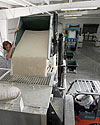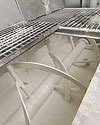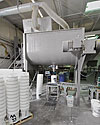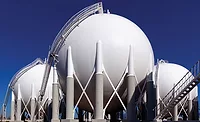Exterior Coatings Producer Blends Abrasives - No Shaft Seal Wear
When Master Wall opened a plant in Payson, UT, the company specified a Munson HD-48-SS ribbon blender to handle the heavy-duty coatings mixing jobs.

Since its founding in 1987, contractors have applied over 100 million square feet of Master Wall Inc. products – stucco, coatings, and exterior insulation and finish systems (EIFS) – on residential, commercial and industrial buildings.
Master Wall founder and President Steve Smithwick says the company’s Aggre-flex EIFS system is “one of the most common commercial cladding in the country.” Also termed “synthetic stucco,” it consists of a water barrier, adhesive, insulation, mesh, basecoat and Master Wall’s “Superior Finishes” topcoat – layered with a trowel. Similarly, Master Wall® “Superior Finishes over Stucco” systems consist of a water barrier, a basecoat and Superior Finishes topcoat. Superior Finishes over Stucco enhances building exteriors with custom colors and textures, ranging from fine to coarse sand, to “Aggre-Flex Superior Stone Finish” resembling cut stone.
The topcoats are a challenge to blend, and require a durable, heavy-duty blender, explains Glen Smith, Manager of Process Engineering at Master Wall. The high-density topcoats, up to 100 lb/cu ft (1600 kg/cu m), are comprised of heavy, abrasive aggregates – coarse particulates of sand and marble – blended with pigments in an acrylic polymer binder. The material caused the shaft seals of Master Wall’s blenders to wear and leak.

In 2006, Master Wall opened a plant in Payson, UT, to better supply the western United States. The company specified a Munson HD-48-SS ribbon blender having a 750-gal (2839 L) capacity equivalent to 150 5-gal (19 L) pails per batch, to handle the heavy-duty coatings mixing jobs.

To prevent the problem, the new blender is equipped with air-purge shaft seals that apply positive pressure to drive abrasive particulates away from the seals, which show no signs of wear or leakage two years after installation.

For more information, visit info@munsonmachinery.com or www.munsonmachinery.com.

Since its founding in 1987, contractors have applied over 100 million square feet of Master Wall Inc. products – stucco, coatings, and exterior insulation and finish systems (EIFS) – on residential, commercial and industrial buildings.
Master Wall founder and President Steve Smithwick says the company’s Aggre-flex EIFS system is “one of the most common commercial cladding in the country.” Also termed “synthetic stucco,” it consists of a water barrier, adhesive, insulation, mesh, basecoat and Master Wall’s “Superior Finishes” topcoat – layered with a trowel. Similarly, Master Wall® “Superior Finishes over Stucco” systems consist of a water barrier, a basecoat and Superior Finishes topcoat. Superior Finishes over Stucco enhances building exteriors with custom colors and textures, ranging from fine to coarse sand, to “Aggre-Flex Superior Stone Finish” resembling cut stone.
The topcoats are a challenge to blend, and require a durable, heavy-duty blender, explains Glen Smith, Manager of Process Engineering at Master Wall. The high-density topcoats, up to 100 lb/cu ft (1600 kg/cu m), are comprised of heavy, abrasive aggregates – coarse particulates of sand and marble – blended with pigments in an acrylic polymer binder. The material caused the shaft seals of Master Wall’s blenders to wear and leak.

A Succession of Blenders
Master Wall’s original mixer was a small, two-speed propeller-type blade unit placed atop a 30-gal (114 L) stainless steel pot, producing only three, 5-gal (19 L) pails of stucco per batch. Master Wall soon acquired a 150-gal (568 L) ribbon blender, and over the next 13 years added two more ribbon blenders (450 gal [1703 L] and 900 gal [3407 L]) to the Lithonia, GA, plant. The ribbon blenders combine the ingredients producing the water barriers, base coats and Superior Finishes topcoats. Today the plant produces thousands of 5-gal (19 L) pails of products in one shift.In 2006, Master Wall opened a plant in Payson, UT, to better supply the western United States. The company specified a Munson HD-48-SS ribbon blender having a 750-gal (2839 L) capacity equivalent to 150 5-gal (19 L) pails per batch, to handle the heavy-duty coatings mixing jobs.

Ribbon Blender Performs Heavy-Duty Task
Air-Purge Seals Solve Leakage Problem
According to Smith, “We run our machines hard.” The blender withstands non-stop, all-day mixing of abrasive material without premature seal leakage. In ribbon blenders, packing glands create a mechanical seal where the shaft penetrates the blender wall. The abrasive material in Master Wall’s blends was wearing away the braided Teflon® packing of the blenders in the Georgia plant, allowing material leaks, requiring packing to be replaced monthly and shafts to eventually be replaced, incurring two to three days of downtime.To prevent the problem, the new blender is equipped with air-purge shaft seals that apply positive pressure to drive abrasive particulates away from the seals, which show no signs of wear or leakage two years after installation.
Improving Operator Safety
Master Wall specified four safety grates that cover the top of the ribbon blender and trip “kill switches” if moved, enhancing operator safety. The safety grates and switches are integrated into the machine with a flush-mount sensor. Master Wall also specified lids with dust-collection ports on the back half of the blender top that rest on heavy-duty stops when open. Negative-pressure dust collectors pull dust out of the blender into a bag house, so that little dust escapes into the work area, despite the quantities of dusty material being used. Low noise levels are another plus for operator safety. The chain that transfers power from the helical gear motor to the blender’s agitator sprocket runs through an oil bath, providing an added measure of safety by reducing noise.
Specifying a Blender
In planning the construction of the Payson, UT, plant, Munson representative Bob Jeremias of TEC Engineering helped engineer the blender and dust collection system while Steve Knauth of Munson configured a model to meet Master Wall’s needs, including safety features and the air-purge shaft seal system. Smith says, “We needed a durable machine. Just looking at the blender you can tell it’s a heavy-duty machine because of its sturdy construction.” The company plans to purchase the same brand of ribbon blenders for its Georgia plant.For more information, visit info@munsonmachinery.com or www.munsonmachinery.com.
Looking for a reprint of this article?
From high-res PDFs to custom plaques, order your copy today!






